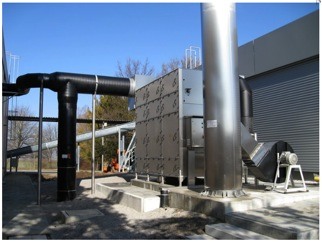UV Oxidation (Photoionization)
The UV – Oxidation or photoionization process is a new odor control technology in the wastewater treatment plant industry, although it has a successful history in removing volatile organic compounds (VOC’s) from air in other industrial applications (primarily aircraft industry paint booths).
UV Oxidation (Photoionization)
The process oxidizes air contaminants through two separate mechanisms:
- Direct photolysis, or chemical decomposition by the action of radiant energy. This process involves excitation of contaminant molecules due to absorption of UV light at frequencies tuned to the contaminants to be removed. This process is similar to the UV disinfection process currently used for final disinfection of wastewater treatment plant effluent.
- Oxidation by “activated oxygen”. Activated oxygen is an oxidant blend of ozone, hydrogen peroxide, atomic oxygen, atomic hydrogen, and hydroxyl radicals generated by UV light. The byproducts of these oxidation reactions are carbon dioxide, oxygen, water, salts, and mild acids. This activated oxygen blend is reported to be about 10% more reactive than ozone alone.
The odorous air is discharged from fans through filters to remove any air-borne particulates, then through a UV light reactor. The air is then passed through a packed bed scrubber where oxidation by activated oxygen-saturated water occurs. The scrubbing liquid is passed through an activated oxygen contact tank to replenish oxidant levels, and recirculated through the scrubber. A minimal amount of caustic is added to the liquid to maintain a pH in the 7 – 8 range. The air is then passed through an activated carbon adsorber for polishing treatment. Activated oxygen may be applied to the activated carbon to keep the carbon free of organic slime growth and to regenerate the carbon by oxidizing the adsorbed contaminants. This regeneration process also decreases carbon replacement costs.
Advantages of this process include low operating costs, high hydrogen sulfide and other reduced sulfur compound removal efficiency, effective treatment of VOC’s, minimal spent media disposal, and minimal chemical storage and handling.
The primary disadvantage is that this is a relatively new technology in the wastewater treatment industry.
Applicable Treatment Processes
All liquid treatment plant processes, sludge thickening, sludge dewatering.
Major Design Considerations
Contaminants to be treated
All three steps of the process should be designed based on the type and concentrations of contaminants to be treated.

